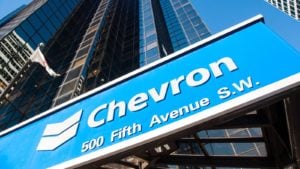It used to be that every responsible long-term investor had some kind of energy company in their portfolio. And by “some kind of energy company,” I mean a big oil and natural gas firm.
They were as much a sure thing as big banking stocks. Well, we’ve seen that banking isn’t what it used to be and the same goes for the energy patch.
And remember, the pandemic was more the final nail rather than the sole factor in the demise of oil companies. Supply had been high for a while as OPEC nations looked to keep prices low to make life hard on U.S.-based production firms.
Then ESG (environmental, social, governance) investing gained traction the shift to renewables began in earnest. More than 80% of the market’s activity is institutional trading, so when they move, the market goes with them.
Finally, the pandemic continues to slow economic recovery in the U.S., Europe and emerging markets. That means less oil and gas demand.
Here are 7 energy stocks to sell before they fall any further:
- BP (NYSE:BP)
- Chevron (NYSE:CVX)
- Royal Dutch Shell (NYSE:RDS.B)
- Concho Resources (NYSE:CXO)
- EOG Resources (NYSE:EOG)
- HollyFrontier (NYSE:HFC)
- Valero (NYSE:VLO)
These energy stocks aren’t likely to disappear, but there’s certainly more risk than reward at this point.
Energy Stocks To Sell: BP (BP)

Good old British Petroleum has been around since 1909, one of the first companies to secure oil rights in what is today Saudi Arabia. It was very influential in the region as a technologically advanced company that could produce and deliver oil to the West and cut host countries in on a profit.
Now its empire spans the world. And while it makes a lot of noise about its renewables efforts the fact is, black gold still makes up a majority of its profits.
And the world is a much different place today and keeps changing. Being a big, integrated oil companies means you can spread your risk across all aspects of the business. But in times like these, that’s not necessarily an advantage, as all energy sectors are hurting.
The stock is off almost 40% in the past year, so its nearly 8% dividend doesn’t provide much temptation.
Chevron (CVX)

When you think of U.S. oil companies, you probably think of Ohio for Standard Oil or in more recent times, Texas. But Chevron actually began, and remains headquartered, in California.
When Standard Oil was broken up in 1911, its Southern California segment eventually turned into Chevron. Today, CVX is a major global integrated oil and gas company.
In 2000, Chevron merged with Texaco to form the second largest U.S. oil company and the fourth largest publicly traded oil company. Today, it has pivoted to natural gas in the U.S. as well as other parts of the world, with a massive natural gas operation in Australia.
But none of this is able to keep CVX at the high prices to which it had become accustomed. And while it’s still a big player, this isn’t a must-have stock for anyone any longer. CVX is off 23% in the past year and its 5.7% dividend doesn’t make that any easier to swallow.
Royal Dutch Shell (RDS.B)

This Anglo-Dutch integrated oil firm is another one that goes all the way back to 1907. And its challenges and troubles are much the same as our previous two companies.
Shell was a giant in an industry that ruled the world for nearly 200 hundred years. And now its farflung empire is becoming a costly remnant of its past. If you want to know how this goes, look at nation states that rule the world for a while, like the U.K., the Netherlands and Portugal.
Managing a global enterprise fundamentally based on a single commodity is quite challenging when that commodity is no longer in demand the way it once was. It’s not that the company will disappear but it will be a shell of the Shell it once was.
The stock is off 32% in the past year and cut its dividend in April for the first time since WW 2.
Concho Resources (CXO)

Launched in 2006, this exploration and production (E&P) company has an $11 billion market cap, so it’s not a small player in the upstream oil business. But with a 1.3% dividend, it’s fundamentally a growth-focused company.
But this isn’t a growth-friendly market right now. On the bright side, the compnany is focused on natural gas from two major shale deposits. But the conversion to natural gas from oil or coal has been usurped by solar and wind.
Granted, there are still huge margins on U.S. natural gas if you can get it to Europe or Asia, but export facilities aren’t plentiful. Domestic gas demand will keep it going, but growth isn’t on the horizon.
CXO stock is off 30% in the past year. It may not have much downside, but it has little upside in the short or intermediate term.
EOG Resources (EOG)

This is another big E&P that sits in the top half of the Fortune 500. But it’s under pressure from Saudi Arabia and the rest of OPEC as well as Russia, which is now working closely with OPEC to access markets and hamstring U.S. producers.
Combine that with a low-demand environment that will likely get worse due to rising pandemic numbers, and it’s a challenging environment even before you throw in ESG investing rotating money out of the industry in general and into alternatives such as electric and hydrogen vehicles.
Certainly the world isn’t going to give up oil anytime soon, but it also won’t be commodity that drives the global economy as it once did.
The stock is off 38% in the past year and that’s up 46% in the past three months. Its 2.7% dividend is nice, but not very useful.
HollyFrontier (HFC)

In the energy patch there are upstream players, which are E&P firms. Midstream players are the pipeline companies. Downstream players are refiners, distributors and retailers. Integrated oils do it all.
HFC is a downstream refiner. It not only sells various fuels and lubricants made of crude but it also sells other offshoots of crude refining.
When the economy is good, there’s demand for these products. When it’s not, demand drops and refiners have less demand to fulfill.
Given the current trends, HFC may see a bump in action as the economy recovers but there are also alternative energy options that are competing with an oil-driven economy, so there may be less business for it grab.
The stock is off 46% in the past year, so its 5.5% dividend doesn’t really mean much unless the stock can maintain its current levels, which may be difficult.
Valero (VLO)

As a refiner and retailer, VLO has broadened its product line to include ethanol and renewable diesel. This certainly helps keep it relevant as the transportation industry transitions, since big trucks still rely on diesel and ethanol is blended with gasoline to cut down on air pollution.
However, if rising investment dollars are going into electric vehicles and more companies are moving into this market, it means increased competition from outside sources for VLO. And a weaker economy means less trucking.
Its 6.7% yield is certainly tempting but the stock is off 37% in the past year and if it continues to fall, that dividend may be in jeopardy.
Disclosure: On the date of publication, Louis Navellier has no positions in stocks in this article. Louis Navellier did not have (either directly or indirectly) any other positions in the securities mentioned in this article.
The InvestorPlace Research Staff member primarily responsible for this article did not hold (either directly or indirectly) any positions in the securities mentioned in this article.
Louis Navellier had an unconventional start, as a grad student who accidentally built a market-beating stock system — with returns rivaling even Warren Buffett. In his latest feat, Louis discovered the “Master Key” to profiting from the biggest tech revolution of this (or any) generation.
